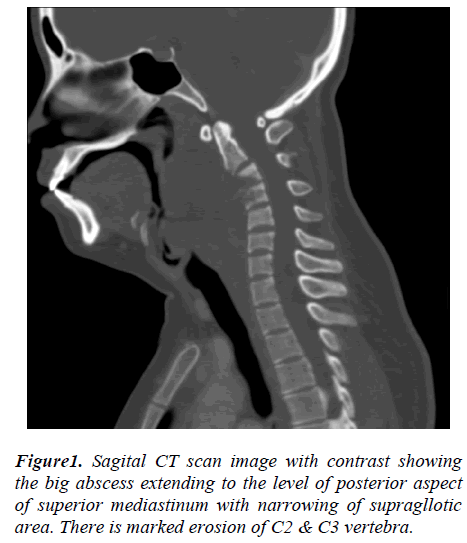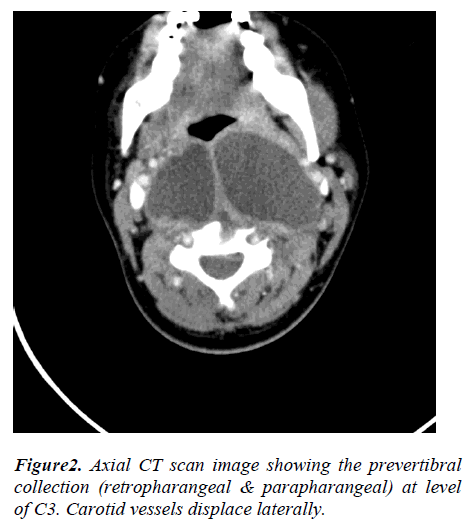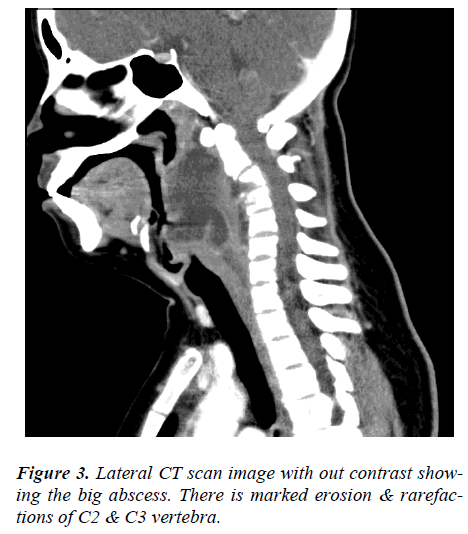ISSN: 0970-938X (Print) | 0976-1683 (Electronic)
Biomedical Research
An International Journal of Medical Sciences
- Biomedical Research (2011) Volume 22, Issue 1
Rare Presentation of a Common Disease (Tuberculous Retropharyngeal abscess)
Mayed. M. Radi and Hussam Makki*
Otolaryngology Department, Hamad Medical Corporation, P. O. Box 3050, Doha, Qatar
- *Corresponding Author:
- Mayed. M. Radi
Otolaryngology Department
Hamad Medical Corporation
P. O. Box 3050, Doha
Qatar
Accepted date: August17 2010
The retropharyngeal space lies in the posterior pharyngeal wall between the middle and deep layers of the deep cervical fascia. It extends from the base of the skull to the mediasti-num and frequently serves as a conduit for spread of disease from the neck into the chest. Spinal tuberculosis is the commonest extra pulmonary manifestation of tuberculosis. Clini-cal findings of cervical tuberculosis included neck pain, restricted neck movements, quadri-paresis, radicular manifestations, kyphosis, and sensory disturbance. It should be suspected in an adult person who presents with a destructive lesion of the cervical vertebra and retro-pharyngeal mass. Early diagnosis and treatment are necessary to prevent the serious com-plications of the disease. We present here a 28 years old Indonesian female came to the Ac-cident & Emergency Department, Hamad General Hospital, Doha, Qatar. She was com-plaining from retropharyngeal abscess with extensive C3, C4 vertebra erosion on CT scan. After history taking, clinical examination doing then followed by hematological & radiologi-cal investigations. The patient was admitted to the hospital. Patient treated with trans-oral Incision and Drainage under GA plus anti tubercles medication. Patient improved & fol-lowed for 3 months then she went back for good to here original country.
Key words
Retropharyngeal space, Abscess, Tuberculosis, Cervical vertebra, Anti Tuberculosis drugs
Introduction
Retropharyngeal abscess results from suppuration of re-tropharyngeal lymph nodes in patients with upper respira-tory tract infection or from traumatic perforation of the pharynx or upper esophagus by a foreign body. If the ab-scess compresses the larynx and upper trachea, symptoms of upper airway obstruction develop. Spinal tuberculosis (Pott's disease) the most common form of skeletal TB is considered the most dangerous because involvement of the spinal cord results in neurological impairment. Lum-bar and thoracic regions are more often involved, whereas the incidence of cervical involvement is 2 to 3 %. [1,2].
The sites of spinal involvement with tuberculous spondy-litis are paradiscal lesion, which is the most common site, central body lesion, anterior type in the anterior part of the vertebrae, appendicular type in the pedicle, lamina, transverse process and articular type in the posterior inter-vertebral joint. [3,4].
The neurological deficit occurring with tuberculous spondylitis either due to cold abscess, granulation tissue, necrotic debris and sequestrae from bone or the intervertebral disc tissue, and occasionally vascular thrombo-sis of the spinal arteries. [5].
Case report
A 28 years old Indonesian female presented to the Acci-dent and Emergency Department at Hamad Hospital complaining from swelling at both sides of the neck for 5 days. The condition associated with difficulty in swallow-ing and slight shortness of breath & restriction in neck movement.
On examination the patient looks ill with bilateral upper neck swelling tenderness & fluctuation sign is positive with no cervical lymphadenopathy. Examination of the oral cavity shows anterior displacement of the posterior pharyngeal wall with congested mucosa overlying. Her vital signs were with in normal range.
She gave history over the last 5 months of low grad fever, night sweat, anorexia, and 10Kg weight loss & both shoulders pain with numbness of both upper limbs. No history of cough, septum, heamoptesis, chest pain or dysponea.
She did not complain from any chronic illness & she did not take any medication.
Urgent Ultrasound and CT scan was done. It confirms a (right side 5.9*3.8 cm & left side 2.3*83.0 cm) retro-pharyngeal abscess with extensive C2, C3 anterior ero-sion.
Hematological investigation shows: WBC 6.4 mainly po-lymorph, hematocrit 34.8, ESR 103 mm/h.
Admission of the patient to the hospital put her on dual aerobic and anaerobic empirical IV antibiotic medications (Rocefine, Clindamycin). With in less than 12 hours from admission patient was on the Operating room table. Under GA trans-oral drainage of this big abscess took place. Swab was taken for gram stain, Acid-fast smear, culture and sensitivity.
2 days later the result of the smear came with positive for acid fast bacilli (4 AFB/100 Fields), Infectious teem con-sulted & they transfer the patient to an isolated room & they starts Anti TB medications (INH, Pyridoxine, Ri-fampicin, Ethambutol, Pyrazinamide) for 6-12 months.
A Neurosurgery physician consulted to examine her. The patient dose not shows any neurological deficit. He rec-ommends wearing a Philadelphia neck collar for her & follows up at out patient.
Early morning sputum samples was collected for 3 con-secutive days was negative for acid fast bacilli, blood cul-ture was negative as well as the chest x-ray did not show any sign for pulmonary TB. On the 4th day MRI on the neck did which shows mild recollection at the same place of the previous abscess.
Patient followed up with daily hematological investiga-tions and clinical examination. She starts to improve dra-matically from her presenting symptoms. Patent dis-charged from the hospital after 10 days & referred to the TB clinic for follow up. She followed up with them for 3 months then she went back to her home country for good.
Discussion
Retropharyngeal tuberculous abscess is a rare presen-tation of the disease even in the presence of extensive pulmonary tuberculosis [6]. Sometimes, retropharyngeal tuberculous abscess causing strider and threatening respiratory obstruction may be the only manifestation [7]. Tuberculous retropharyngeal abscess in adults is usually secondary to tuberculous involvement of cervical spine. [8]. the probable route of spread of tuberculosis to retropharyngeal space is via the lymphatic to a persistent retropharyngeal lymph node. Rarely, the abscess may be due to hemotogenous spread from pulmonary tuberculosis or tuberculosis elsewhere [9]. Tuberculous infection cau-ses destruction, caseation, and necrosis of vertebrae or may present as an abscess. The abscess may remain close to the vertebra and present on the radiograph as pre vertebral or Para vertebral abscess or it may move distally along the tissue planes to present as cold abscess. [3,10]. A delay in diagnosis and treatment can increase the risk of complications, including a spontaneous rupture of the abscess that can lead to trachea-bronchial aspiration or strider secondary to laryngeal edema. Early diagnosis is also essential in order to prevent the onset or progression of the neurological sequel of Pott's disease. [12].
A retro-pharyngeal abscess can be drained safely via a trans-oral route or by an external route. [11]. It is well accepted that if the spine is stable and there is no neurolo-gical deficit, or minimal neurological signs, anti tuber-culosis drug therapy and conservative neck stabilization should be the initial treatment. If neurological signs are prominent on patient admission or develop later, or if there is cervical insatiability or significant degree of sub-luxation, then surgical debridement and stabilization are indicated. [13,14]
References
- Fang D, Leong J, Fang H. Tuberculosis of the upper cervical spine .J Bone Joint Surg [Br] 1983 ;65 :47-50 .<br>
- Govender S, Charles R: Tuberculosis of the cervical spine Neuro Orthopedics 1991; 11:101-107.<br>
- Hsu L, Leong J. Tuberculosis of the lower cervical spine [C2 -C7]: A report on 40 cases J Bone Joint Surg 1984, 66 B: 1-5.<br>
- Trovlos J, Toit G Du .Spinal tuberculosis: beware of the posterior elements .J Bone Joint Surg 1990; 72-B: 772.<br>
- Jain AK, Kumar S, Tuli SM .Tuberculosis of spine [C1-D4] . Spinal Cord 1999, 37[5]: 362-369.<br>
- Melchor Diaz MA, Domingo Carrasco C., Monge Jodra R, Marino Espuelas J, Ontanon Martin M, Tuberculous Retropharyngeal Abscess in an HIV Patient- Report of a Case, Acta Otorhinolaryngol Esp, 1993, 44(6), 467
- Carroll N., Bain RJ, Tseung MH. Edwards RH. Tuber-culous Retropharyngeal Abscess producing respiratory obstruction, Thorax, 1989, 44 (7), 599
- Mathur NN., Bais AS, Tubercular Retropharyngeal Abscess in Early Childhood, Ind J Pediatr, 1997, 64 (6), 898
- Rice DH, Dimcheff DG, Benz R. Tsang AV., Retro-pharyngeal Abscess caused by Atypical Mycobacte-rium, Arch Otolaryngol, 1977, 103 (11),
- Nussbaum E, Gaylan LR, Bergman TA et al .Spinal tuberculosis: a diagnostic and management challenge .J Neurosurgery. 1995 83: 243-247.
- Raj TB, Zarod AP, Acute Non-tuberculous Retro-pharyngeal Abscess in Adults (Case Reports of three patients), J.laryngolOtology, 1985, 99 (12), 1997.
- Neal SL, Kearns M J, Seelig JM, Jefferey HP. Mani-festations of Pott's disease in the head and neck. Laryn-goscope 1986; 96: 494-496.
- Cary ME, Infections of the spine & spinal cord In: Youmans JR, ed. Neurological Surgery. 4th edn, vol, 5. Philadelphia. WB Saunders, 1996; 3: 270-304.
- Behari S, Nayak SR, Bahragava V, et al. Craniocervical tuberculosis: protocol of surgical management. Neu-rosurgery 2003: 52 (1): 72-81.


